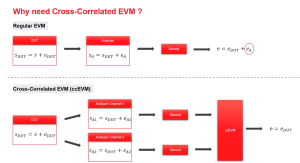BY PARIS. A
(PRODUCT MARKETING MANAGER)
5G already extends into millimeter-wave (mmWave) bands and with the advent of 6G, download speeds of 1 TB per second and one microsecond latency will soon be possible. As frequency increases, the propagation losses increase as well. Signal quality is more susceptible to modulation errors, phase noise, distortion, and other impairments. To maintain the same system performance, devices must meet more stringent linearity requirements.
Higher frequency and wider analysis bandwidth capabilities are extremely important to characterize the next generation of wireless and communication devices. Keysight launched the N9032 PXA X-Series Signal Analyzer for RF and microwave applications last year. This analyzer covered frequency ranges up to 8.4, 13.6, and 26.5 GHz at the time of the launch and we are now expanding the frequency coverage to mmWave ranges. We just introduced two new frequency models for 44 and 50 GHz in the N9032B PXA family, that enable 5G new radio (NR) frequency range (FR)2 applications. Same as the RF and microwave version, the new mmWave N9032B offers up to 2 GHz analysis bandwidth. Now we have three models available for 50 GHz signal analysis frequency coverage, at 2 GHz signal analysis bandwidth: the N9032B PXA, the N9040B UXA, and the N9042B UXA X-Series Signal Analyzers. Here are some highlights about the new N9032 PXA X-Series Signal Analyzer:
Unmatched RF/uW Bandwidth:
- The only 8.4, 13.6, and 50 GHz signal analyzer family on the market with up to 2 GHz of analysis bandwidth (4 times wider bandwidth compared to existing models)
- Perfect for wide bandwidth applications including 5G carrier aggregation, 5G amplifier test, 802.11 ax/be, and satellite communication standards.
Superior Performance:
- See small signals near noise and quickly find spurs without having to narrow real time bandwidth and slow sweep speed, with the best sweep displayed average noise level (DANL) (-163 dBm/Hz at 26.5 GHz, and -156 dBm/Hz at 50 GHz)
- Characterize your transmitters more accurately with the best EVM residuals and sensitivity
- Order of magnitude improvement in accuracy by compensating for path losses with U9361 RCal calibrator
Space/Cost Saving:
- All the performance you expect in a 6U-high signal analyzer, now available in a 4U-high form factor
- 33% space savings
- Easy drop-in and replacement for your legacy rack mounted signal analyzer
Today mmWave technology transforms wireless communications. The wireless systems achieve higher data throughput and super-fine rich resolution using ultra-wide bandwidth. The challenges for engineers in these areas are the fact that R&D and design validation tests (DVT) need 3 to 5 times bandwidth for digital pre-distortion (DPD) applications, as well as low error vector magnitude (EVM) to characterize the 5G or WiFi components and devices.
EVM is the most widely used modulation quality metric in digital communications systems, used to quantify the performance of a digital radio transmitter or receiver. It quantifies the performance of transmitters, receivers, and software-defined radios. EVM provides an overall indication of waveform distortion, representing characteristics of a device’s phase, amplitude, and noise.
Keysight has introduced a new technique called cross-correlated EVM (ccEVM), and has applied it on the N9032B PXA as well as many other high performance signal analyzers. ccEVM is available with the PathWave test signal analysis software such as 89601EVMC PathWave VSA, N9054EM0E/N9054EM1E/N9077EM0E/N9077EM1E/N9077EM2E/N9085EM0E PathWave X-App measurement applications to help you get an even more accurate measurement of your device’s EVM. ccEVM is a technique used to extend the dynamic range of a receiver for best EVM performance. By using two receivers you can capture and demodulate the same signal independently and perform cross-correlation on the error vectors to cancel out uncorrelated noise from the receivers, to get a much lower EVM. This technique causes the ccEVM value to primarily contain just the noise coming from the device under test (DUT) (Figure 1). The ccEVM on the N9032B provides impressive improvement for wideband noise-dominated signals. It’s very helpful when measuring DUTs with very low EVM or requiring accurate EVM at low output powers, where displayed average noise level (DANL) of analyzer normally limits the performance.
Figure 1: Cross-correlated EVM (ccEVM) Measurement Technique
Source: https://blogs.keysight.com/blogs/tech/rfmw.entry.html/2023/01/19/revealed_the_newtechniquetoachievethelowest-m2Cx.html










